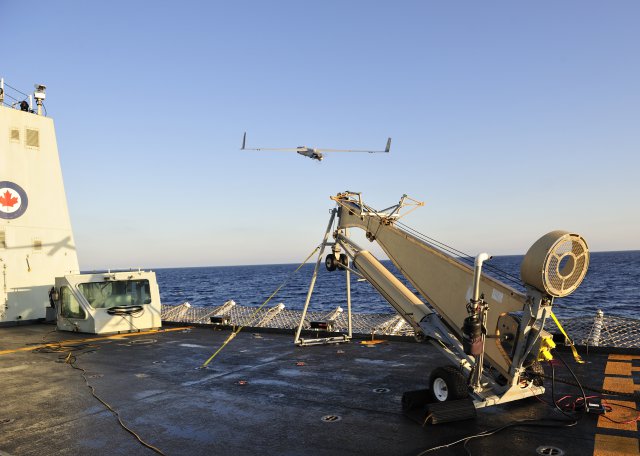 In late August, HMCS Charlottetown wraps up a seven-month deployment and bids farewell to the ScanEagle unmanned aircraft detachment that shared the flight deck with Osprey, the Halifax-class frigate’s CH-124 Sea King helicopter.
In late August, HMCS Charlottetown wraps up a seven-month deployment and bids farewell to the ScanEagle unmanned aircraft detachment that shared the flight deck with Osprey, the Halifax-class frigate’s CH-124 Sea King helicopter.
Charlottetown is the first Canadian warship to carry a UAS detachment throughout an expeditionary deployment.
UAS are new to the Canadian Forces — the first was the CU-161 Sperwer, which entered service in Afghanistan in February 2006 — so the skills required to launch, fly, recover and maintain them are still sourced from a variety of military occupations in the Canadian Army, the Royal Canadian Navy and the Royal Canadian Air Force. Because the ScanEagle is still under trial, the Charlottetown UAS detachment included civilian technicians as well as soldiers, sailors and airmen.
Integrating and synchronizing all their capabilities required a high degree of collaboration among the UAS detachment’s members. This teamwork produced an exceptional synergy.
“Coming from the Army, there were certain things that my team and I had to adjust to when operating in a marine environment,” said Sergeant Michael Jenkins of the Royal Canadian Artillery, the senior UAS operator and controller on HMCS Charlottetown. “The constant movement of the ship made launch and recovery different from on land, and there was naval lingo and acronyms that we had to learn to be able to operate smoothly with the sailors in the Ops Room.”
The Operations Room is the nerve centre of this collaborative effort. Typically, the ship detects a vessel on radar or receives an intelligence report about a “vessel of interest.” Traditionally, a ship reacts in one of two ways: intercept the vessel and investigate it, or send the helicopter out to locate the vessel and assess the situation. With the UAV detachment, HMCS Charlottetown had a third option: send the ScanEagle to track the vessel covertly while transmitting a live video feed straight to the Operations Room.
“I’ve been with the ScanEagle from the beginning,” said Sergeant Jenkins. “For me the most important part of flying a UAS is the surveillance it provides for frontline soldiers or, in the Navy, the boarding party.”
A true CF pioneer, Sgt Jenkins deployed to Afghanistan in 2006 with the first Sperwer detachment. Now he is a key member of Canada’s first sea-going UAS team.
Life in a warship was an eye-opening exerience for the civilian members of the Charlottetown UAS detachment, who come from the Ottawa-based robotics firm ING Engineering. ““Adjusting to the sea state and feeling seasick at the beginning was difficult. Add to that the constant sound of daily pipes telling you when to eat, sleep and where to be, and it’s definitely a unique way to live,”” said technician Blair Callaghan.
ING Engineering technician Garth Matheson took the long view. “As with anything else, the more the process is repeated the smoother it gets,” he said. “As technicians working with the Navy and with 4 Air Defence Regiment [Royal Canadian Artillery], out of CFB Gagetown, we understand — as do they — that educating each other on our roles and responsibilities is key to making this deployment a success.”
HMCS Charlottetown’s commanding officer, Commander Wade Carter, appreciates the flexibility of his combined air detachment. “UAS will never fully replace the requirement for a maritime helicopter and its crew at sea,” he said. “While the ship and the helicopter are ideal for locating vessels of interest, the UAS provides covert, stealth surveillance with a live video feed that enables the operations team to collect data and imagery of illicit activities to build a case for follow-on action or interdiction. It’s my hope that the CF will continue to strive toward a collaborative approach in future naval deployments.”
HMCS Charlottetown left her home port of Halifax, N.S. on 8 January 2012. From 24 January to 20 April 2012, she served with Standing NATO Maritime Group 1 on Operation ACTIVE ENDEAVOUR in the Mediterranean Sea. In April, Charlottetown was re-tasked to join Combined Task Force 150 (CTF-150), the multinational fleet conducting counter-terrorism operations in the Arabian Sea, the Gulf of Aden, the Gulf of Oman and the Indian Ocean. HMCS Regina is scheduled to replace her in CTF-150 during the third week of August, and Charlottetown will then begin the journey back across the Atlantic. She is expected to arrive in Halifax in mid-September.
